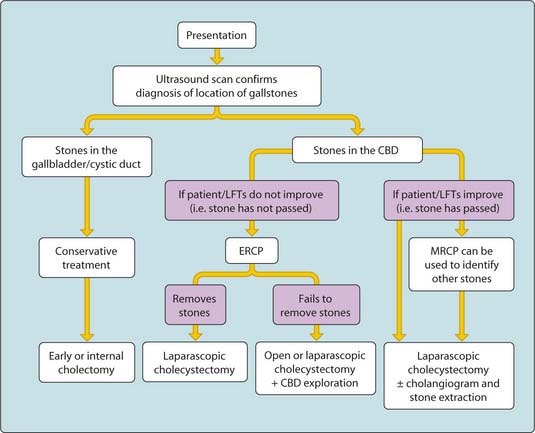4 Management of gallstone disease
Cholecystectomy (surgical removal of the gallbladder) is the ‘gold standard’ of treatment for gallstone disease. Remember asymptomatic stones require no treatment. Figure 3.4.1 shows the algorithm for acute management:
 common acute gallstone disease (biliary colic, acute cholecystitis, obstructive jaundice) is managed conservatively initially to allow the stone to pass spontaneously
common acute gallstone disease (biliary colic, acute cholecystitis, obstructive jaundice) is managed conservatively initially to allow the stone to pass spontaneously mucoceles, empyemas or ascending cholangitis require immediate drainage of the biliary tree with endoscopic retrograde cholangiopancreatography (ERCP) or cholecystectomy (Table 3.4.1).
mucoceles, empyemas or ascending cholangitis require immediate drainage of the biliary tree with endoscopic retrograde cholangiopancreatography (ERCP) or cholecystectomy (Table 3.4.1).
Fig. 3.4.1 Principles of treatment for acute biliary colic, acute cholecystitis and obstructive jaundice.
Table 3.4.1 Specific Management In Gallstone Disease
| Management | |
|---|---|
| Mucocele | Removed by urgent/early laparoscopic cholecystectomy |
| Empyema | Resucitate with fluids and antibiotics; requires urgent cholecystectomy or percutaneous drainage (cholecystostomy, under ultrasound guidance) |
| Ascending cholangitis | Urgent decompression of the biliary system using ERCP with antibiotics and fluid resuscitation; if unsuccessful then open surgery to remove stone in common bile duct |
| Gallstone pancreatitis | ERCP is required to remove the offending stone (open cholecystectomy if this fails) |
ERCP, endoscopic retrograde cholangiopancreatography.
With conservative regimens, 90% of patients improve:
< div class='tao-gold-member'>
Only gold members can continue reading. Log In or Register to continue











